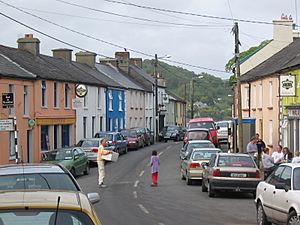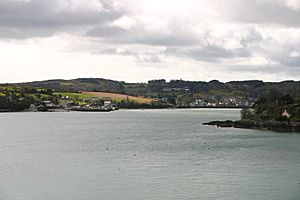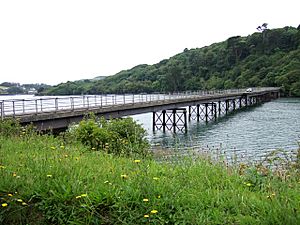Union Hall, County Cork facts for kids
Quick facts for kids
Union Hall
Bréantrá (Irish)
|
|
|---|---|
|
Village
|
|

Main Street
|
|
| Country | Ireland |
| Province | Munster |
| County | County Cork |
| District | Skibbereen |
| Elevation | 0 m (0 ft) |
| Population | 270 |
| Time zone | UTC+0 (WET) |
| • Summer (DST) | UTC-1 (IST (WEST)) |
| Irish Grid Reference | W206345 |
Union Hall (Irish: Bréantrá), also called Unionhall, is a small fishing village in County Cork, Ireland. It sits on the west side of Glandore Harbour. To its west is Castletownshend, and to its east is Glandore village. Union Hall is about 10 kilometres south-east of Skibbereen. In 2016, 270 people lived in Union Hall.
Fishing is a main job here. The pier has an ice plant and a fish processing factory. Tourism is also important. Visitors can take boat trips to see amazing animals like whales, dolphins, and seals.
Where is Union Hall?
This village is on a hill near the coast. It has a small harbour for fishing boats and other small ships.
You can reach Union Hall by road using the R597 regional road. This road leads to Glandore, Rosscarbery, and Leap. You will cross the narrow Poulgorm Bridge. This bridge is only wide enough for one car at a time. So, cars must wait for it to be clear before crossing. The bridge was built around 1890. It was even shown in the 1994 movie "War of the Buttons".
A Look at Union Hall's Past
Around Union Hall, you can find old sites from history. There are remains of ringforts, which were old circular forts. You can also see a souterrain, which is an underground passage. A lime kiln was also found.
There are also ruins of old castles. These castles belonged to the O'Donovan family. One castle from the 1200s is at Castle Eyre. Another from the 1500s is Raheen Castle.
The Irish name for Union Hall is Bréantrá. This means "rotten strand." Another Irish name is Trá an Bhróin, which means "strand of sorrow." One story says the name comes from a battle. Blood was spilled there in the early 1500s. The battle was between two groups of the O'Donovan family.
The English name "Union Hall" came from a large house. This house was built after the Act of Union 1800. It was named by William Somerville Limrick. He was a soldier in the East India Company. Later, this house was called Unionhall House. It was burned down during a time of conflict in Ireland.
In 2012, a fishing boat called the Tit Bonhomme sank. This happened near Glandore Harbour. The people of Union Hall spent many weeks searching. They looked for the Irish and Egyptian sailors who died. For their efforts, the community received a special "People of the Year Award" in 2012.
Things to Do and See
Union Hall has a supermarket and a fish shop. There is also a post office. You can find several bed and breakfasts if you want to stay overnight.
The village has two churches. One is a Roman Catholic church, built around 1832. It is called St. Bridget's. The other is a Church of Ireland church, built around 1840.
The area around Union Hall is beautiful. It has hills, forests, rivers, and islands. There are also many small bays and beaches to explore.
See also
 In Spanish: Unionhall para niños
In Spanish: Unionhall para niños




